CQUniversity PPMP20014: Solid Waste Management in Australia Report
VerifiedAdded on 2022/12/15
|26
|6369
|68
Report
AI Summary
This report delves into the complexities of solid waste management in Australia, framing it as a 'wicked problem.' It begins with an abstract and table of contents, followed by an introduction outlining the scale of the issue, which is driven by population growth and the associated waste generation, with a focus on landfill practices and waste exports. The literature review explores complexity factors and ICCPM outcomes, emphasizing the multidimensional nature of solid waste management. The report details the challenges of waste generation, including environmental impacts and current management practices such as landfilling, incineration, and reuse, alongside the risks associated with these practices, like groundwater contamination and greenhouse gas emissions. The methodology section explains the use of a scorecard and radar diagram for complexity analysis, identifying key stakeholders and their influences, including political and social factors. It also addresses project governance and the impact of technology. The report concludes with a proposed framework for changing the current management context and a list of references, providing a comprehensive overview of the solid waste management issues in Australia.
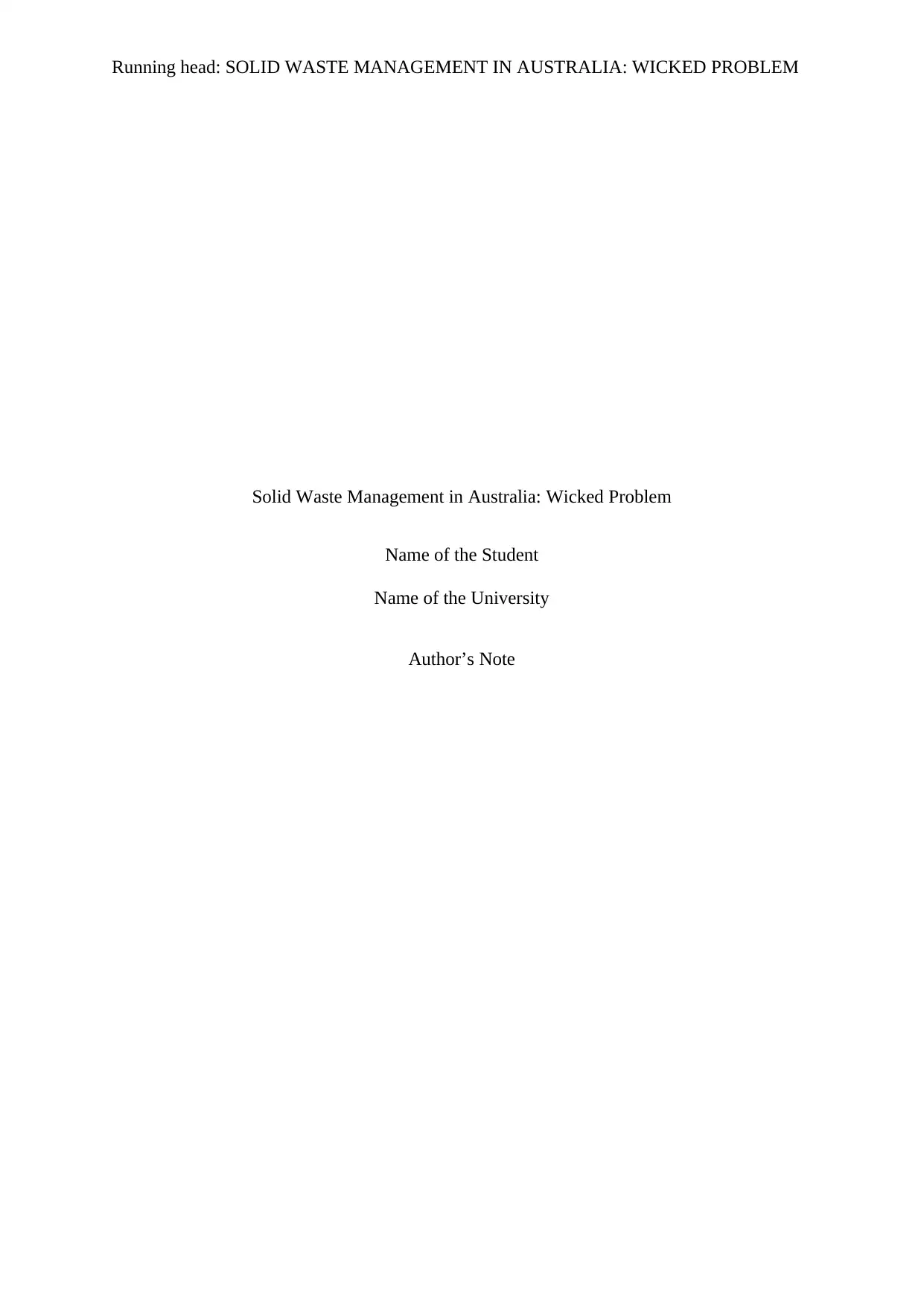
Running head: SOLID WASTE MANAGEMENT IN AUSTRALIA: WICKED PROBLEM
Solid Waste Management in Australia: Wicked Problem
Name of the Student
Name of the University
Author’s Note
Solid Waste Management in Australia: Wicked Problem
Name of the Student
Name of the University
Author’s Note
Paraphrase This Document
Need a fresh take? Get an instant paraphrase of this document with our AI Paraphraser
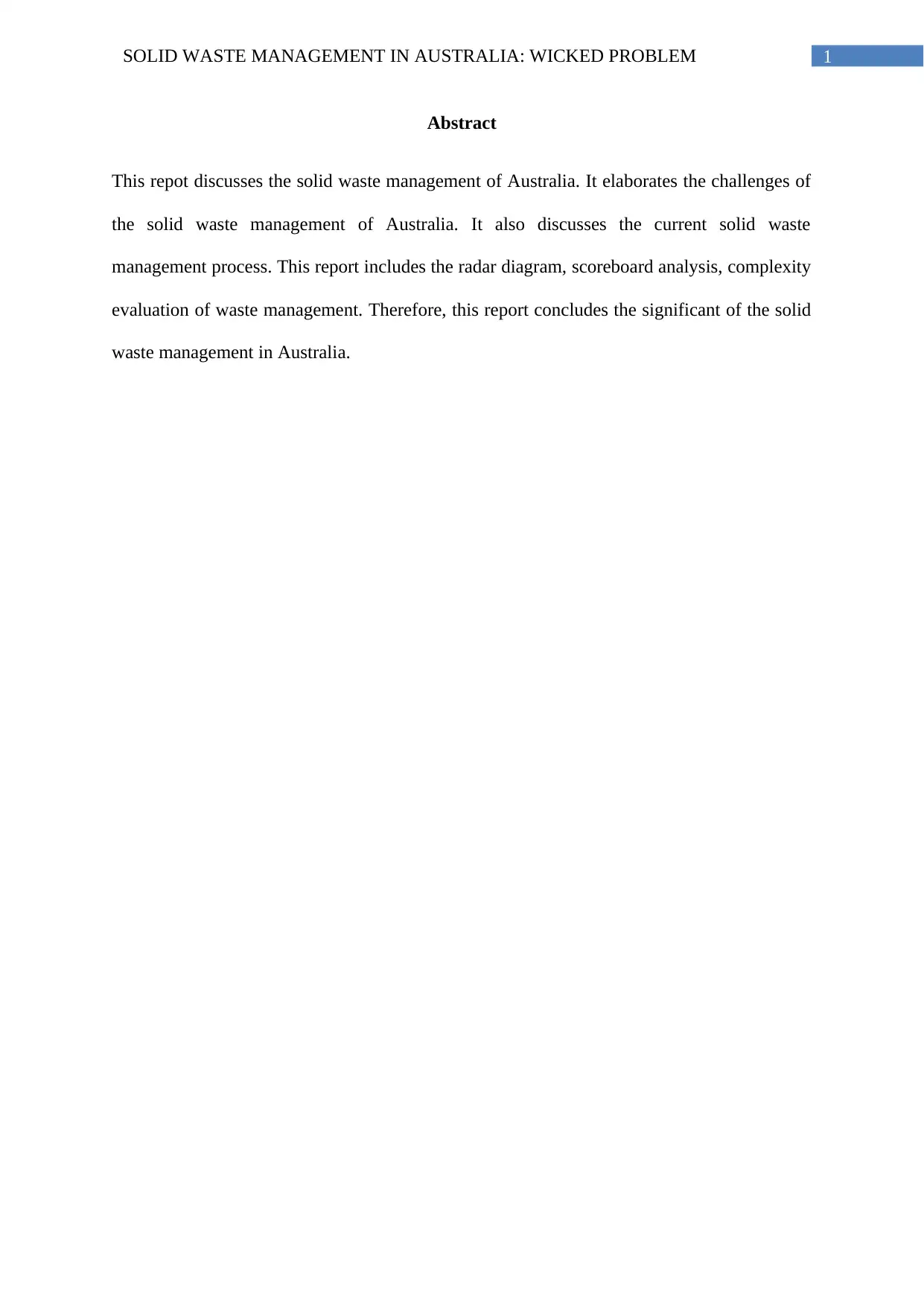
1SOLID WASTE MANAGEMENT IN AUSTRALIA: WICKED PROBLEM
Abstract
This repot discusses the solid waste management of Australia. It elaborates the challenges of
the solid waste management of Australia. It also discusses the current solid waste
management process. This report includes the radar diagram, scoreboard analysis, complexity
evaluation of waste management. Therefore, this report concludes the significant of the solid
waste management in Australia.
Abstract
This repot discusses the solid waste management of Australia. It elaborates the challenges of
the solid waste management of Australia. It also discusses the current solid waste
management process. This report includes the radar diagram, scoreboard analysis, complexity
evaluation of waste management. Therefore, this report concludes the significant of the solid
waste management in Australia.
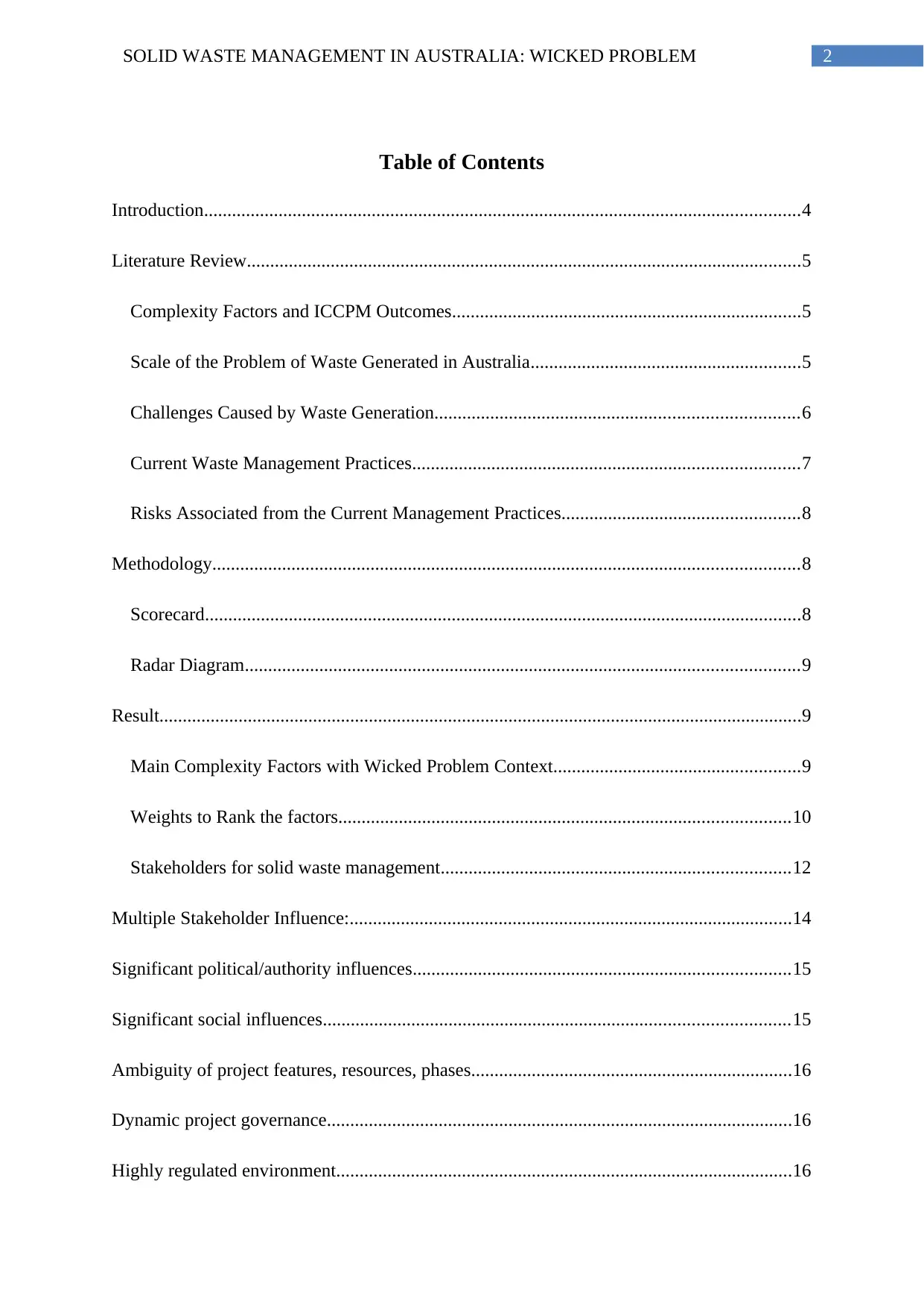
2SOLID WASTE MANAGEMENT IN AUSTRALIA: WICKED PROBLEM
Table of Contents
Introduction................................................................................................................................4
Literature Review.......................................................................................................................5
Complexity Factors and ICCPM Outcomes...........................................................................5
Scale of the Problem of Waste Generated in Australia..........................................................5
Challenges Caused by Waste Generation..............................................................................6
Current Waste Management Practices...................................................................................7
Risks Associated from the Current Management Practices...................................................8
Methodology..............................................................................................................................8
Scorecard................................................................................................................................8
Radar Diagram.......................................................................................................................9
Result..........................................................................................................................................9
Main Complexity Factors with Wicked Problem Context.....................................................9
Weights to Rank the factors.................................................................................................10
Stakeholders for solid waste management...........................................................................12
Multiple Stakeholder Influence:...............................................................................................14
Significant political/authority influences.................................................................................15
Significant social influences....................................................................................................15
Ambiguity of project features, resources, phases.....................................................................16
Dynamic project governance....................................................................................................16
Highly regulated environment..................................................................................................16
Table of Contents
Introduction................................................................................................................................4
Literature Review.......................................................................................................................5
Complexity Factors and ICCPM Outcomes...........................................................................5
Scale of the Problem of Waste Generated in Australia..........................................................5
Challenges Caused by Waste Generation..............................................................................6
Current Waste Management Practices...................................................................................7
Risks Associated from the Current Management Practices...................................................8
Methodology..............................................................................................................................8
Scorecard................................................................................................................................8
Radar Diagram.......................................................................................................................9
Result..........................................................................................................................................9
Main Complexity Factors with Wicked Problem Context.....................................................9
Weights to Rank the factors.................................................................................................10
Stakeholders for solid waste management...........................................................................12
Multiple Stakeholder Influence:...............................................................................................14
Significant political/authority influences.................................................................................15
Significant social influences....................................................................................................15
Ambiguity of project features, resources, phases.....................................................................16
Dynamic project governance....................................................................................................16
Highly regulated environment..................................................................................................16
⊘ This is a preview!⊘
Do you want full access?
Subscribe today to unlock all pages.

Trusted by 1+ million students worldwide
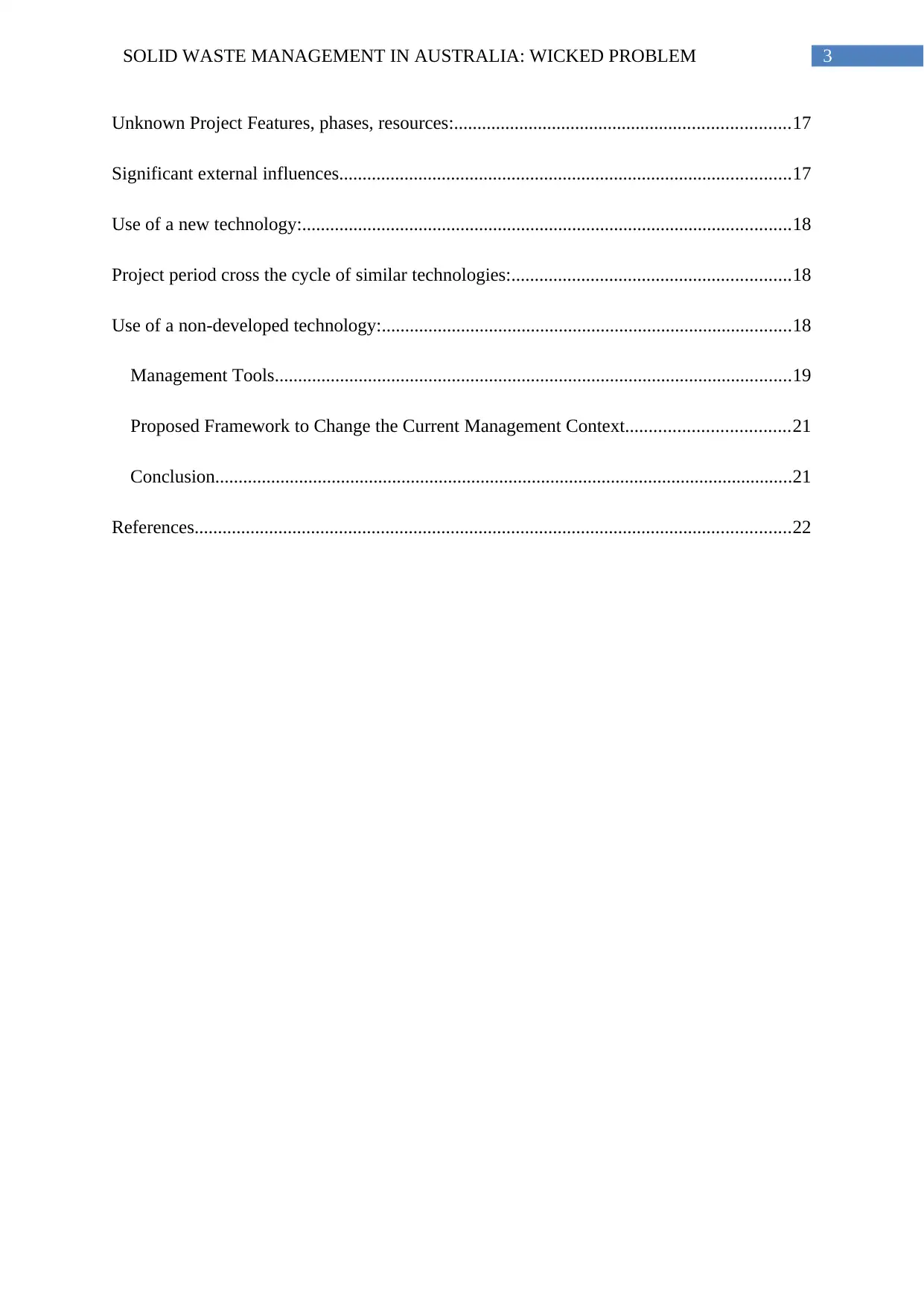
3SOLID WASTE MANAGEMENT IN AUSTRALIA: WICKED PROBLEM
Unknown Project Features, phases, resources:........................................................................17
Significant external influences.................................................................................................17
Use of a new technology:.........................................................................................................18
Project period cross the cycle of similar technologies:............................................................18
Use of a non-developed technology:........................................................................................18
Management Tools...............................................................................................................19
Proposed Framework to Change the Current Management Context...................................21
Conclusion............................................................................................................................21
References................................................................................................................................22
Unknown Project Features, phases, resources:........................................................................17
Significant external influences.................................................................................................17
Use of a new technology:.........................................................................................................18
Project period cross the cycle of similar technologies:............................................................18
Use of a non-developed technology:........................................................................................18
Management Tools...............................................................................................................19
Proposed Framework to Change the Current Management Context...................................21
Conclusion............................................................................................................................21
References................................................................................................................................22
Paraphrase This Document
Need a fresh take? Get an instant paraphrase of this document with our AI Paraphraser
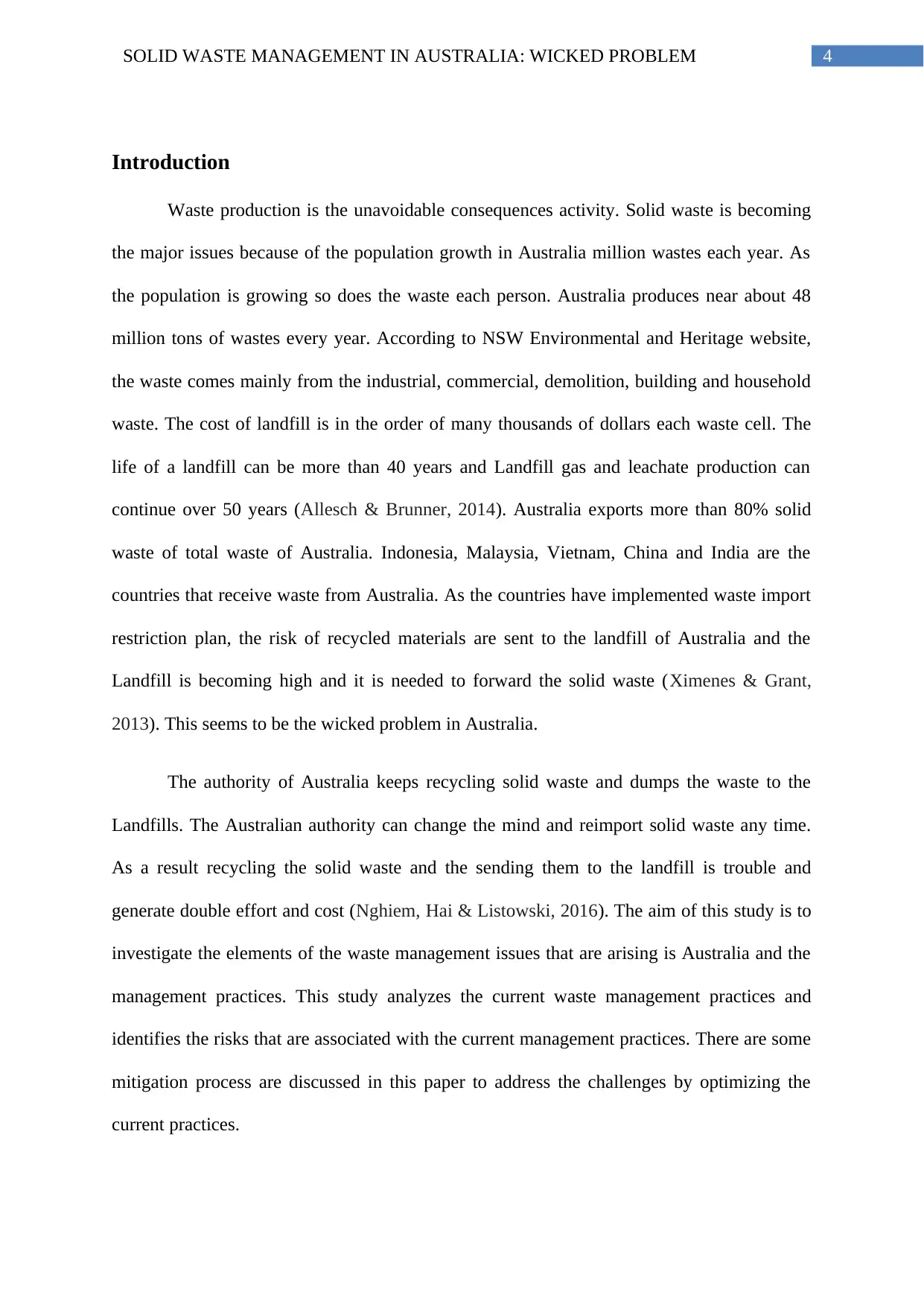
4SOLID WASTE MANAGEMENT IN AUSTRALIA: WICKED PROBLEM
Introduction
Waste production is the unavoidable consequences activity. Solid waste is becoming
the major issues because of the population growth in Australia million wastes each year. As
the population is growing so does the waste each person. Australia produces near about 48
million tons of wastes every year. According to NSW Environmental and Heritage website,
the waste comes mainly from the industrial, commercial, demolition, building and household
waste. The cost of landfill is in the order of many thousands of dollars each waste cell. The
life of a landfill can be more than 40 years and Landfill gas and leachate production can
continue over 50 years (Allesch & Brunner, 2014). Australia exports more than 80% solid
waste of total waste of Australia. Indonesia, Malaysia, Vietnam, China and India are the
countries that receive waste from Australia. As the countries have implemented waste import
restriction plan, the risk of recycled materials are sent to the landfill of Australia and the
Landfill is becoming high and it is needed to forward the solid waste (Ximenes & Grant,
2013). This seems to be the wicked problem in Australia.
The authority of Australia keeps recycling solid waste and dumps the waste to the
Landfills. The Australian authority can change the mind and reimport solid waste any time.
As a result recycling the solid waste and the sending them to the landfill is trouble and
generate double effort and cost (Nghiem, Hai & Listowski, 2016). The aim of this study is to
investigate the elements of the waste management issues that are arising is Australia and the
management practices. This study analyzes the current waste management practices and
identifies the risks that are associated with the current management practices. There are some
mitigation process are discussed in this paper to address the challenges by optimizing the
current practices.
Introduction
Waste production is the unavoidable consequences activity. Solid waste is becoming
the major issues because of the population growth in Australia million wastes each year. As
the population is growing so does the waste each person. Australia produces near about 48
million tons of wastes every year. According to NSW Environmental and Heritage website,
the waste comes mainly from the industrial, commercial, demolition, building and household
waste. The cost of landfill is in the order of many thousands of dollars each waste cell. The
life of a landfill can be more than 40 years and Landfill gas and leachate production can
continue over 50 years (Allesch & Brunner, 2014). Australia exports more than 80% solid
waste of total waste of Australia. Indonesia, Malaysia, Vietnam, China and India are the
countries that receive waste from Australia. As the countries have implemented waste import
restriction plan, the risk of recycled materials are sent to the landfill of Australia and the
Landfill is becoming high and it is needed to forward the solid waste (Ximenes & Grant,
2013). This seems to be the wicked problem in Australia.
The authority of Australia keeps recycling solid waste and dumps the waste to the
Landfills. The Australian authority can change the mind and reimport solid waste any time.
As a result recycling the solid waste and the sending them to the landfill is trouble and
generate double effort and cost (Nghiem, Hai & Listowski, 2016). The aim of this study is to
investigate the elements of the waste management issues that are arising is Australia and the
management practices. This study analyzes the current waste management practices and
identifies the risks that are associated with the current management practices. There are some
mitigation process are discussed in this paper to address the challenges by optimizing the
current practices.
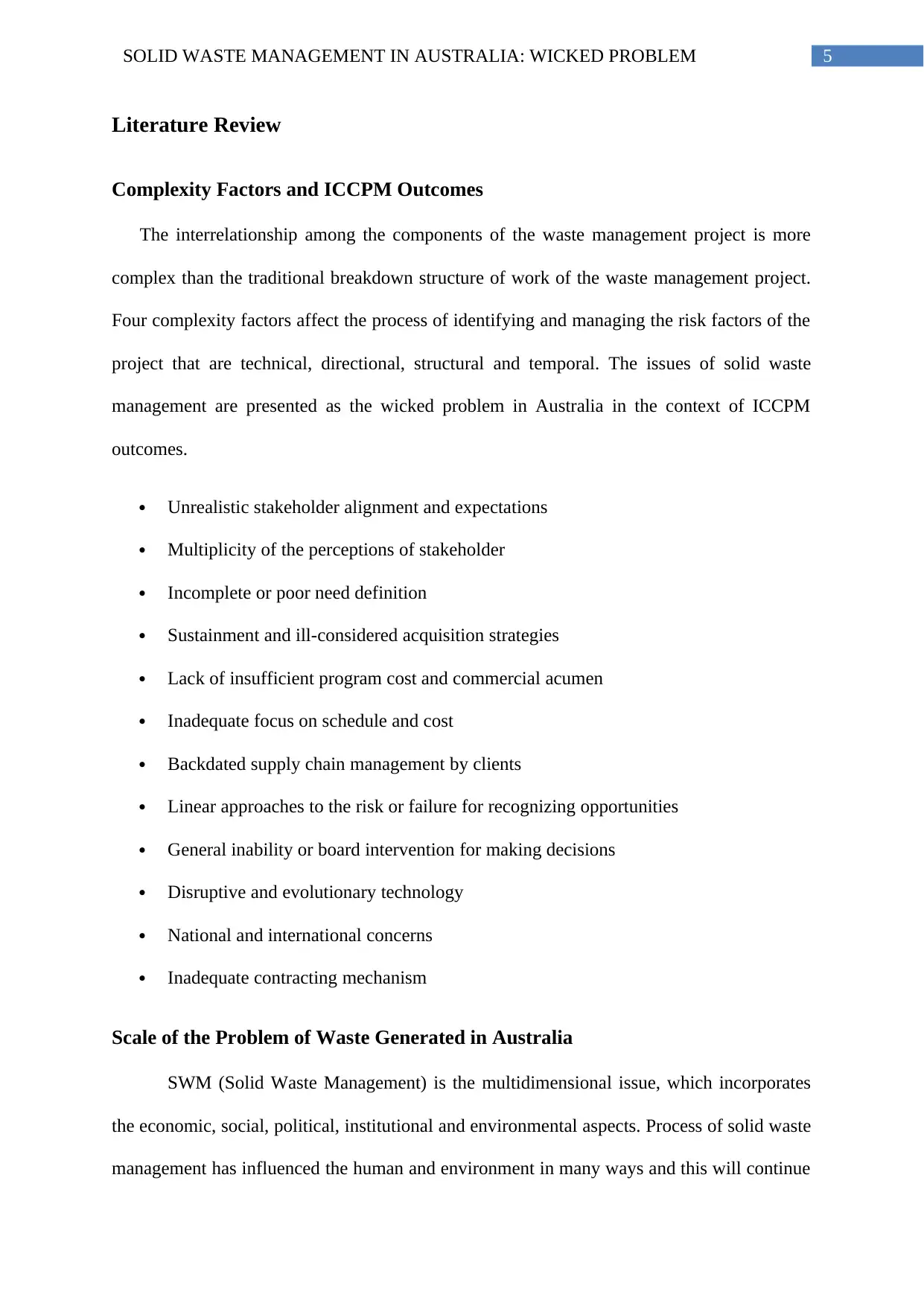
5SOLID WASTE MANAGEMENT IN AUSTRALIA: WICKED PROBLEM
Literature Review
Complexity Factors and ICCPM Outcomes
The interrelationship among the components of the waste management project is more
complex than the traditional breakdown structure of work of the waste management project.
Four complexity factors affect the process of identifying and managing the risk factors of the
project that are technical, directional, structural and temporal. The issues of solid waste
management are presented as the wicked problem in Australia in the context of ICCPM
outcomes.
Unrealistic stakeholder alignment and expectations
Multiplicity of the perceptions of stakeholder
Incomplete or poor need definition
Sustainment and ill-considered acquisition strategies
Lack of insufficient program cost and commercial acumen
Inadequate focus on schedule and cost
Backdated supply chain management by clients
Linear approaches to the risk or failure for recognizing opportunities
General inability or board intervention for making decisions
Disruptive and evolutionary technology
National and international concerns
Inadequate contracting mechanism
Scale of the Problem of Waste Generated in Australia
SWM (Solid Waste Management) is the multidimensional issue, which incorporates
the economic, social, political, institutional and environmental aspects. Process of solid waste
management has influenced the human and environment in many ways and this will continue
Literature Review
Complexity Factors and ICCPM Outcomes
The interrelationship among the components of the waste management project is more
complex than the traditional breakdown structure of work of the waste management project.
Four complexity factors affect the process of identifying and managing the risk factors of the
project that are technical, directional, structural and temporal. The issues of solid waste
management are presented as the wicked problem in Australia in the context of ICCPM
outcomes.
Unrealistic stakeholder alignment and expectations
Multiplicity of the perceptions of stakeholder
Incomplete or poor need definition
Sustainment and ill-considered acquisition strategies
Lack of insufficient program cost and commercial acumen
Inadequate focus on schedule and cost
Backdated supply chain management by clients
Linear approaches to the risk or failure for recognizing opportunities
General inability or board intervention for making decisions
Disruptive and evolutionary technology
National and international concerns
Inadequate contracting mechanism
Scale of the Problem of Waste Generated in Australia
SWM (Solid Waste Management) is the multidimensional issue, which incorporates
the economic, social, political, institutional and environmental aspects. Process of solid waste
management has influenced the human and environment in many ways and this will continue
⊘ This is a preview!⊘
Do you want full access?
Subscribe today to unlock all pages.

Trusted by 1+ million students worldwide
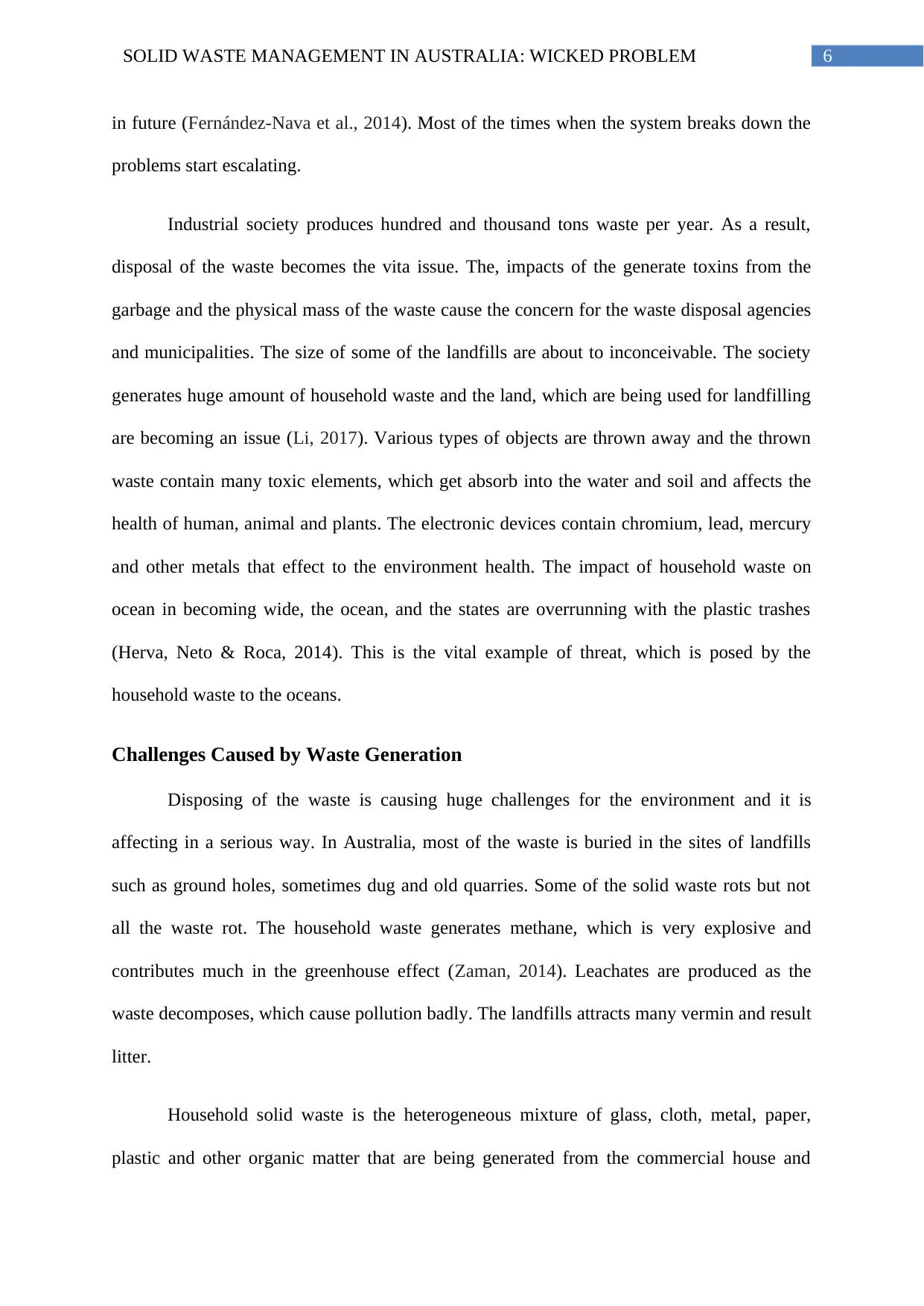
6SOLID WASTE MANAGEMENT IN AUSTRALIA: WICKED PROBLEM
in future (Fernández-Nava et al., 2014). Most of the times when the system breaks down the
problems start escalating.
Industrial society produces hundred and thousand tons waste per year. As a result,
disposal of the waste becomes the vita issue. The, impacts of the generate toxins from the
garbage and the physical mass of the waste cause the concern for the waste disposal agencies
and municipalities. The size of some of the landfills are about to inconceivable. The society
generates huge amount of household waste and the land, which are being used for landfilling
are becoming an issue (Li, 2017). Various types of objects are thrown away and the thrown
waste contain many toxic elements, which get absorb into the water and soil and affects the
health of human, animal and plants. The electronic devices contain chromium, lead, mercury
and other metals that effect to the environment health. The impact of household waste on
ocean in becoming wide, the ocean, and the states are overrunning with the plastic trashes
(Herva, Neto & Roca, 2014). This is the vital example of threat, which is posed by the
household waste to the oceans.
Challenges Caused by Waste Generation
Disposing of the waste is causing huge challenges for the environment and it is
affecting in a serious way. In Australia, most of the waste is buried in the sites of landfills
such as ground holes, sometimes dug and old quarries. Some of the solid waste rots but not
all the waste rot. The household waste generates methane, which is very explosive and
contributes much in the greenhouse effect (Zaman, 2014). Leachates are produced as the
waste decomposes, which cause pollution badly. The landfills attracts many vermin and result
litter.
Household solid waste is the heterogeneous mixture of glass, cloth, metal, paper,
plastic and other organic matter that are being generated from the commercial house and
in future (Fernández-Nava et al., 2014). Most of the times when the system breaks down the
problems start escalating.
Industrial society produces hundred and thousand tons waste per year. As a result,
disposal of the waste becomes the vita issue. The, impacts of the generate toxins from the
garbage and the physical mass of the waste cause the concern for the waste disposal agencies
and municipalities. The size of some of the landfills are about to inconceivable. The society
generates huge amount of household waste and the land, which are being used for landfilling
are becoming an issue (Li, 2017). Various types of objects are thrown away and the thrown
waste contain many toxic elements, which get absorb into the water and soil and affects the
health of human, animal and plants. The electronic devices contain chromium, lead, mercury
and other metals that effect to the environment health. The impact of household waste on
ocean in becoming wide, the ocean, and the states are overrunning with the plastic trashes
(Herva, Neto & Roca, 2014). This is the vital example of threat, which is posed by the
household waste to the oceans.
Challenges Caused by Waste Generation
Disposing of the waste is causing huge challenges for the environment and it is
affecting in a serious way. In Australia, most of the waste is buried in the sites of landfills
such as ground holes, sometimes dug and old quarries. Some of the solid waste rots but not
all the waste rot. The household waste generates methane, which is very explosive and
contributes much in the greenhouse effect (Zaman, 2014). Leachates are produced as the
waste decomposes, which cause pollution badly. The landfills attracts many vermin and result
litter.
Household solid waste is the heterogeneous mixture of glass, cloth, metal, paper,
plastic and other organic matter that are being generated from the commercial house and
Paraphrase This Document
Need a fresh take? Get an instant paraphrase of this document with our AI Paraphraser
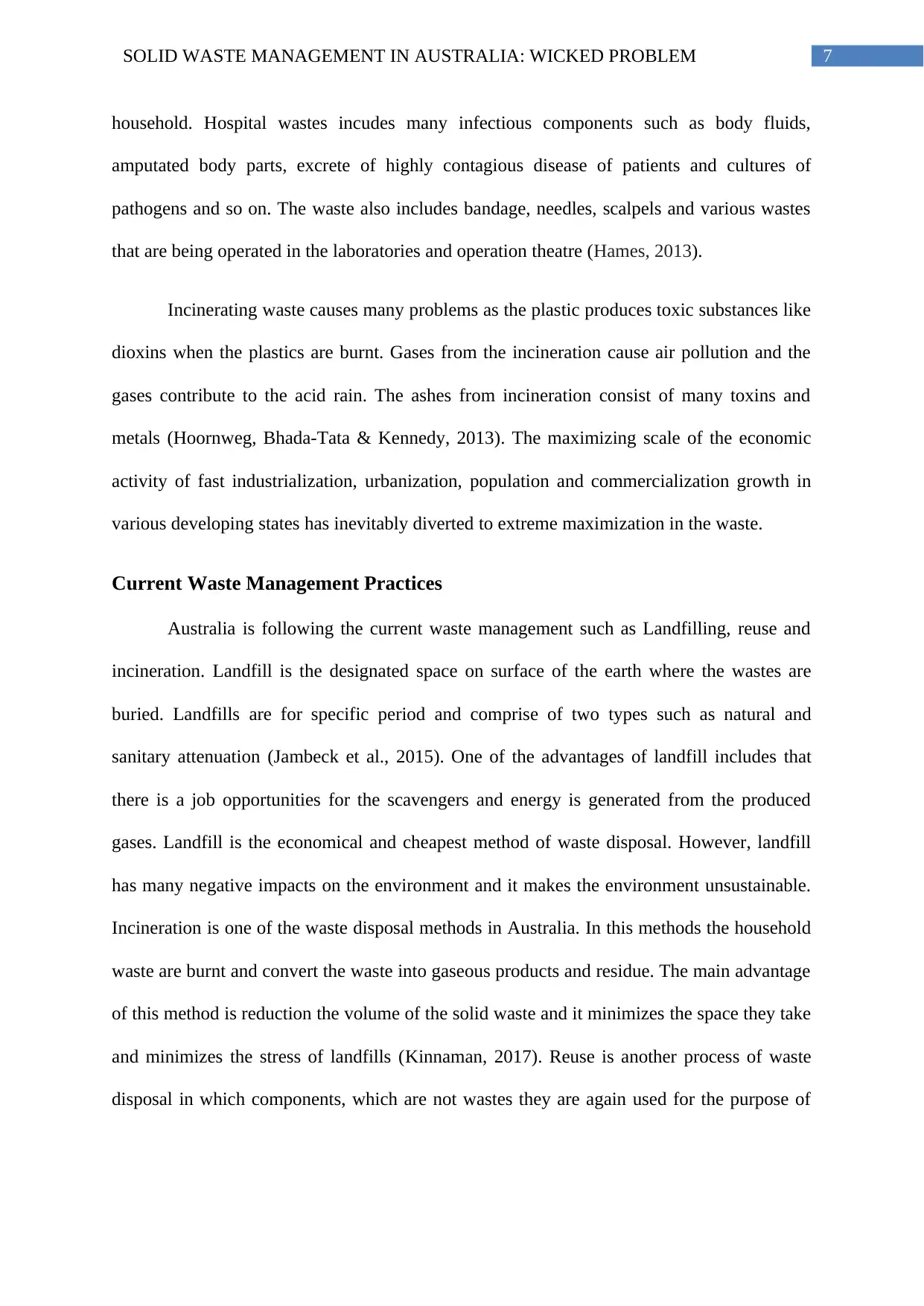
7SOLID WASTE MANAGEMENT IN AUSTRALIA: WICKED PROBLEM
household. Hospital wastes incudes many infectious components such as body fluids,
amputated body parts, excrete of highly contagious disease of patients and cultures of
pathogens and so on. The waste also includes bandage, needles, scalpels and various wastes
that are being operated in the laboratories and operation theatre (Hames, 2013).
Incinerating waste causes many problems as the plastic produces toxic substances like
dioxins when the plastics are burnt. Gases from the incineration cause air pollution and the
gases contribute to the acid rain. The ashes from incineration consist of many toxins and
metals (Hoornweg, Bhada-Tata & Kennedy, 2013). The maximizing scale of the economic
activity of fast industrialization, urbanization, population and commercialization growth in
various developing states has inevitably diverted to extreme maximization in the waste.
Current Waste Management Practices
Australia is following the current waste management such as Landfilling, reuse and
incineration. Landfill is the designated space on surface of the earth where the wastes are
buried. Landfills are for specific period and comprise of two types such as natural and
sanitary attenuation (Jambeck et al., 2015). One of the advantages of landfill includes that
there is a job opportunities for the scavengers and energy is generated from the produced
gases. Landfill is the economical and cheapest method of waste disposal. However, landfill
has many negative impacts on the environment and it makes the environment unsustainable.
Incineration is one of the waste disposal methods in Australia. In this methods the household
waste are burnt and convert the waste into gaseous products and residue. The main advantage
of this method is reduction the volume of the solid waste and it minimizes the space they take
and minimizes the stress of landfills (Kinnaman, 2017). Reuse is another process of waste
disposal in which components, which are not wastes they are again used for the purpose of
household. Hospital wastes incudes many infectious components such as body fluids,
amputated body parts, excrete of highly contagious disease of patients and cultures of
pathogens and so on. The waste also includes bandage, needles, scalpels and various wastes
that are being operated in the laboratories and operation theatre (Hames, 2013).
Incinerating waste causes many problems as the plastic produces toxic substances like
dioxins when the plastics are burnt. Gases from the incineration cause air pollution and the
gases contribute to the acid rain. The ashes from incineration consist of many toxins and
metals (Hoornweg, Bhada-Tata & Kennedy, 2013). The maximizing scale of the economic
activity of fast industrialization, urbanization, population and commercialization growth in
various developing states has inevitably diverted to extreme maximization in the waste.
Current Waste Management Practices
Australia is following the current waste management such as Landfilling, reuse and
incineration. Landfill is the designated space on surface of the earth where the wastes are
buried. Landfills are for specific period and comprise of two types such as natural and
sanitary attenuation (Jambeck et al., 2015). One of the advantages of landfill includes that
there is a job opportunities for the scavengers and energy is generated from the produced
gases. Landfill is the economical and cheapest method of waste disposal. However, landfill
has many negative impacts on the environment and it makes the environment unsustainable.
Incineration is one of the waste disposal methods in Australia. In this methods the household
waste are burnt and convert the waste into gaseous products and residue. The main advantage
of this method is reduction the volume of the solid waste and it minimizes the space they take
and minimizes the stress of landfills (Kinnaman, 2017). Reuse is another process of waste
disposal in which components, which are not wastes they are again used for the purpose of
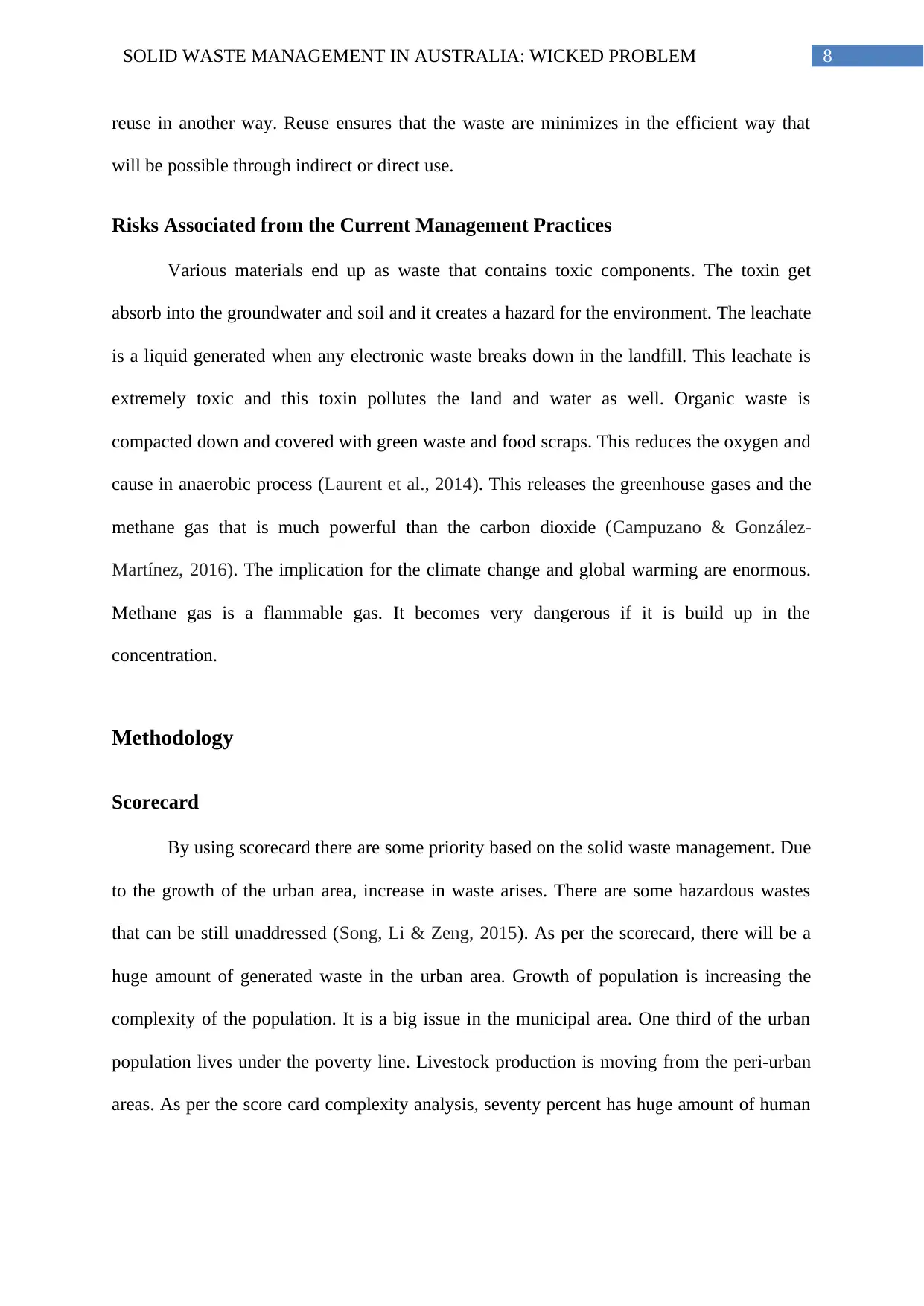
8SOLID WASTE MANAGEMENT IN AUSTRALIA: WICKED PROBLEM
reuse in another way. Reuse ensures that the waste are minimizes in the efficient way that
will be possible through indirect or direct use.
Risks Associated from the Current Management Practices
Various materials end up as waste that contains toxic components. The toxin get
absorb into the groundwater and soil and it creates a hazard for the environment. The leachate
is a liquid generated when any electronic waste breaks down in the landfill. This leachate is
extremely toxic and this toxin pollutes the land and water as well. Organic waste is
compacted down and covered with green waste and food scraps. This reduces the oxygen and
cause in anaerobic process (Laurent et al., 2014). This releases the greenhouse gases and the
methane gas that is much powerful than the carbon dioxide (Campuzano & González-
Martínez, 2016). The implication for the climate change and global warming are enormous.
Methane gas is a flammable gas. It becomes very dangerous if it is build up in the
concentration.
Methodology
Scorecard
By using scorecard there are some priority based on the solid waste management. Due
to the growth of the urban area, increase in waste arises. There are some hazardous wastes
that can be still unaddressed (Song, Li & Zeng, 2015). As per the scorecard, there will be a
huge amount of generated waste in the urban area. Growth of population is increasing the
complexity of the population. It is a big issue in the municipal area. One third of the urban
population lives under the poverty line. Livestock production is moving from the peri-urban
areas. As per the score card complexity analysis, seventy percent has huge amount of human
reuse in another way. Reuse ensures that the waste are minimizes in the efficient way that
will be possible through indirect or direct use.
Risks Associated from the Current Management Practices
Various materials end up as waste that contains toxic components. The toxin get
absorb into the groundwater and soil and it creates a hazard for the environment. The leachate
is a liquid generated when any electronic waste breaks down in the landfill. This leachate is
extremely toxic and this toxin pollutes the land and water as well. Organic waste is
compacted down and covered with green waste and food scraps. This reduces the oxygen and
cause in anaerobic process (Laurent et al., 2014). This releases the greenhouse gases and the
methane gas that is much powerful than the carbon dioxide (Campuzano & González-
Martínez, 2016). The implication for the climate change and global warming are enormous.
Methane gas is a flammable gas. It becomes very dangerous if it is build up in the
concentration.
Methodology
Scorecard
By using scorecard there are some priority based on the solid waste management. Due
to the growth of the urban area, increase in waste arises. There are some hazardous wastes
that can be still unaddressed (Song, Li & Zeng, 2015). As per the scorecard, there will be a
huge amount of generated waste in the urban area. Growth of population is increasing the
complexity of the population. It is a big issue in the municipal area. One third of the urban
population lives under the poverty line. Livestock production is moving from the peri-urban
areas. As per the score card complexity analysis, seventy percent has huge amount of human
⊘ This is a preview!⊘
Do you want full access?
Subscribe today to unlock all pages.

Trusted by 1+ million students worldwide
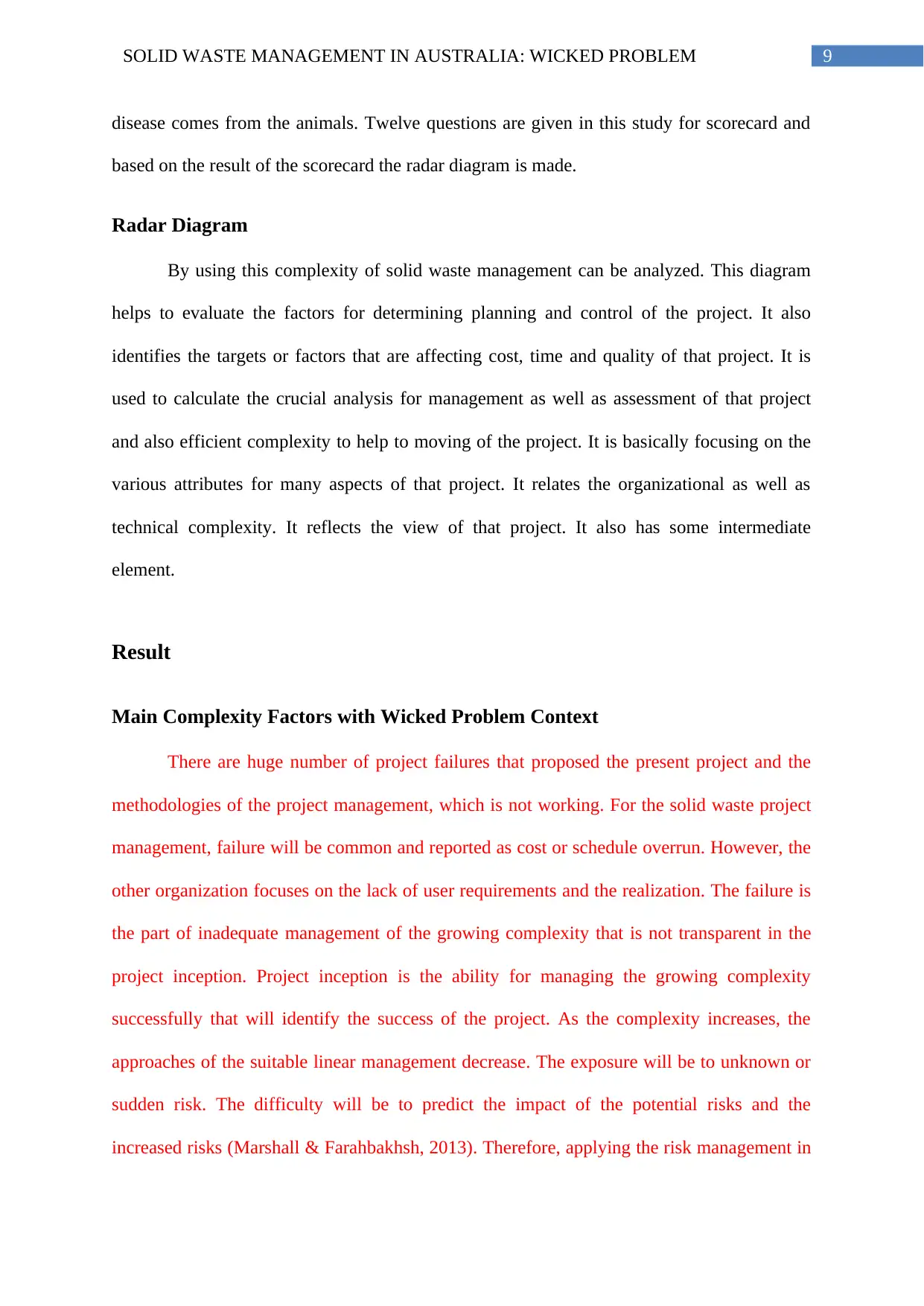
9SOLID WASTE MANAGEMENT IN AUSTRALIA: WICKED PROBLEM
disease comes from the animals. Twelve questions are given in this study for scorecard and
based on the result of the scorecard the radar diagram is made.
Radar Diagram
By using this complexity of solid waste management can be analyzed. This diagram
helps to evaluate the factors for determining planning and control of the project. It also
identifies the targets or factors that are affecting cost, time and quality of that project. It is
used to calculate the crucial analysis for management as well as assessment of that project
and also efficient complexity to help to moving of the project. It is basically focusing on the
various attributes for many aspects of that project. It relates the organizational as well as
technical complexity. It reflects the view of that project. It also has some intermediate
element.
Result
Main Complexity Factors with Wicked Problem Context
There are huge number of project failures that proposed the present project and the
methodologies of the project management, which is not working. For the solid waste project
management, failure will be common and reported as cost or schedule overrun. However, the
other organization focuses on the lack of user requirements and the realization. The failure is
the part of inadequate management of the growing complexity that is not transparent in the
project inception. Project inception is the ability for managing the growing complexity
successfully that will identify the success of the project. As the complexity increases, the
approaches of the suitable linear management decrease. The exposure will be to unknown or
sudden risk. The difficulty will be to predict the impact of the potential risks and the
increased risks (Marshall & Farahbakhsh, 2013). Therefore, applying the risk management in
disease comes from the animals. Twelve questions are given in this study for scorecard and
based on the result of the scorecard the radar diagram is made.
Radar Diagram
By using this complexity of solid waste management can be analyzed. This diagram
helps to evaluate the factors for determining planning and control of the project. It also
identifies the targets or factors that are affecting cost, time and quality of that project. It is
used to calculate the crucial analysis for management as well as assessment of that project
and also efficient complexity to help to moving of the project. It is basically focusing on the
various attributes for many aspects of that project. It relates the organizational as well as
technical complexity. It reflects the view of that project. It also has some intermediate
element.
Result
Main Complexity Factors with Wicked Problem Context
There are huge number of project failures that proposed the present project and the
methodologies of the project management, which is not working. For the solid waste project
management, failure will be common and reported as cost or schedule overrun. However, the
other organization focuses on the lack of user requirements and the realization. The failure is
the part of inadequate management of the growing complexity that is not transparent in the
project inception. Project inception is the ability for managing the growing complexity
successfully that will identify the success of the project. As the complexity increases, the
approaches of the suitable linear management decrease. The exposure will be to unknown or
sudden risk. The difficulty will be to predict the impact of the potential risks and the
increased risks (Marshall & Farahbakhsh, 2013). Therefore, applying the risk management in
Paraphrase This Document
Need a fresh take? Get an instant paraphrase of this document with our AI Paraphraser
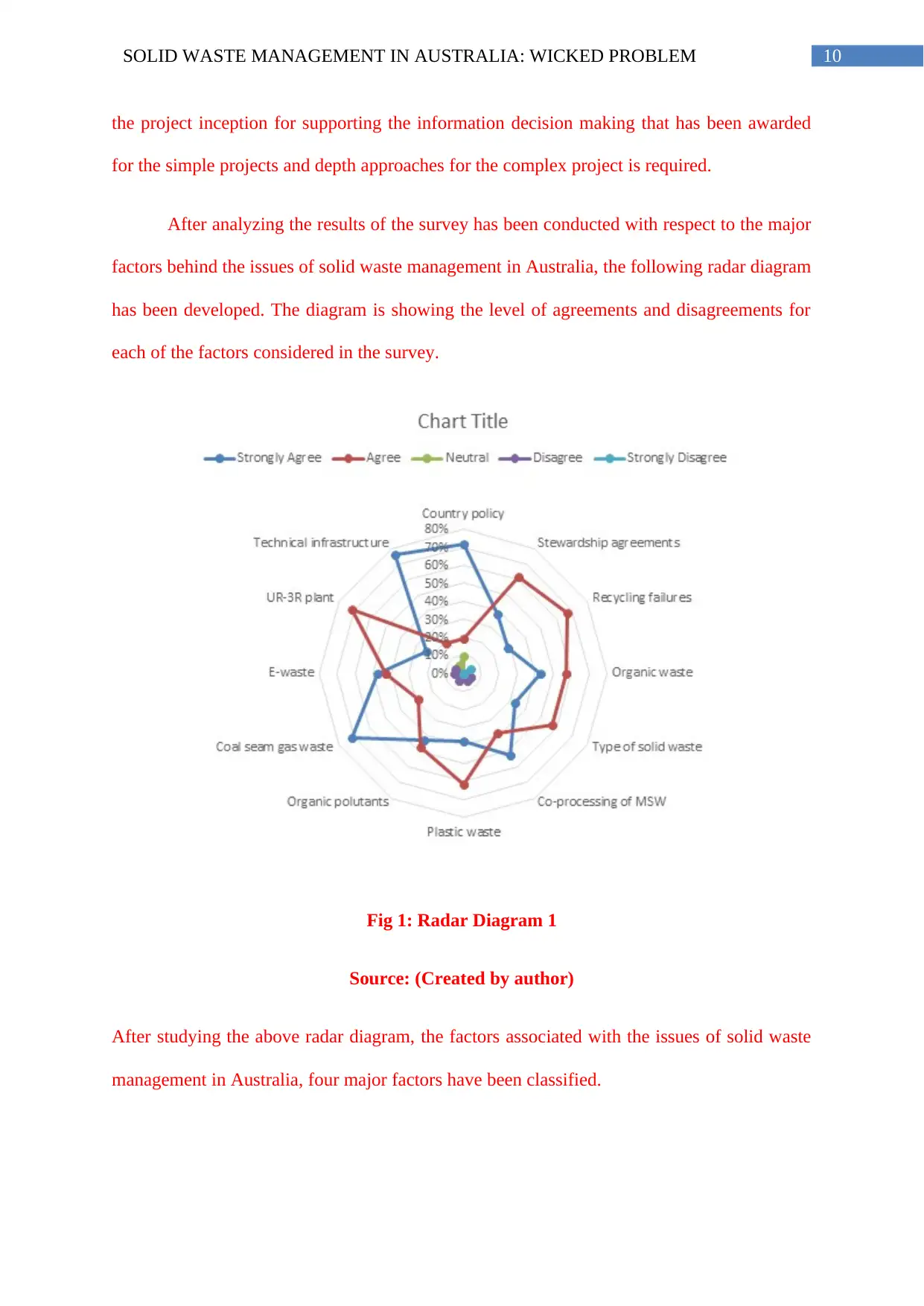
10SOLID WASTE MANAGEMENT IN AUSTRALIA: WICKED PROBLEM
the project inception for supporting the information decision making that has been awarded
for the simple projects and depth approaches for the complex project is required.
After analyzing the results of the survey has been conducted with respect to the major
factors behind the issues of solid waste management in Australia, the following radar diagram
has been developed. The diagram is showing the level of agreements and disagreements for
each of the factors considered in the survey.
Fig 1: Radar Diagram 1
Source: (Created by author)
After studying the above radar diagram, the factors associated with the issues of solid waste
management in Australia, four major factors have been classified.
the project inception for supporting the information decision making that has been awarded
for the simple projects and depth approaches for the complex project is required.
After analyzing the results of the survey has been conducted with respect to the major
factors behind the issues of solid waste management in Australia, the following radar diagram
has been developed. The diagram is showing the level of agreements and disagreements for
each of the factors considered in the survey.
Fig 1: Radar Diagram 1
Source: (Created by author)
After studying the above radar diagram, the factors associated with the issues of solid waste
management in Australia, four major factors have been classified.
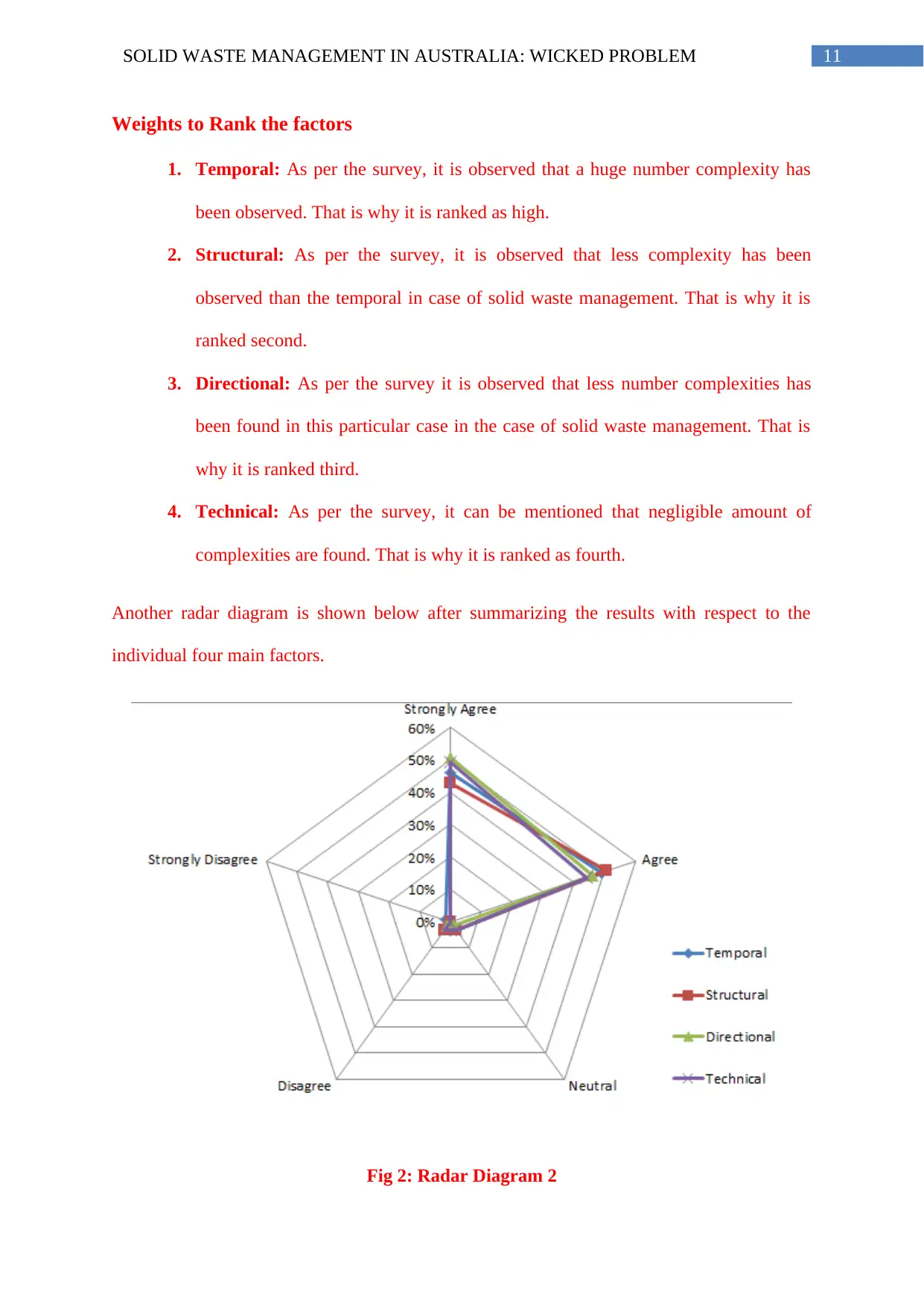
11SOLID WASTE MANAGEMENT IN AUSTRALIA: WICKED PROBLEM
Weights to Rank the factors
1. Temporal: As per the survey, it is observed that a huge number complexity has
been observed. That is why it is ranked as high.
2. Structural: As per the survey, it is observed that less complexity has been
observed than the temporal in case of solid waste management. That is why it is
ranked second.
3. Directional: As per the survey it is observed that less number complexities has
been found in this particular case in the case of solid waste management. That is
why it is ranked third.
4. Technical: As per the survey, it can be mentioned that negligible amount of
complexities are found. That is why it is ranked as fourth.
Another radar diagram is shown below after summarizing the results with respect to the
individual four main factors.
Fig 2: Radar Diagram 2
Weights to Rank the factors
1. Temporal: As per the survey, it is observed that a huge number complexity has
been observed. That is why it is ranked as high.
2. Structural: As per the survey, it is observed that less complexity has been
observed than the temporal in case of solid waste management. That is why it is
ranked second.
3. Directional: As per the survey it is observed that less number complexities has
been found in this particular case in the case of solid waste management. That is
why it is ranked third.
4. Technical: As per the survey, it can be mentioned that negligible amount of
complexities are found. That is why it is ranked as fourth.
Another radar diagram is shown below after summarizing the results with respect to the
individual four main factors.
Fig 2: Radar Diagram 2
⊘ This is a preview!⊘
Do you want full access?
Subscribe today to unlock all pages.

Trusted by 1+ million students worldwide
1 out of 26
Related Documents
Your All-in-One AI-Powered Toolkit for Academic Success.
+13062052269
info@desklib.com
Available 24*7 on WhatsApp / Email
![[object Object]](/_next/static/media/star-bottom.7253800d.svg)
Unlock your academic potential
Copyright © 2020–2025 A2Z Services. All Rights Reserved. Developed and managed by ZUCOL.




